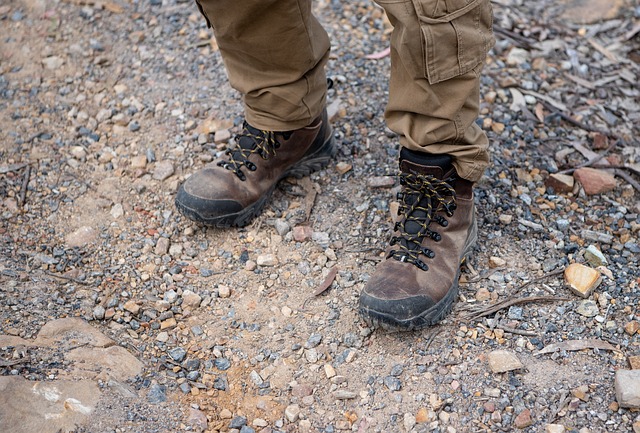Are you tired of soggy feet and uncomfortable hikes due to wet leather boots? Well, you’re in luck! In this step-by-step guide, I’ll show you how to waterproof your leather hiking boots effectively. By the end of this article, you’ll be equipped with the knowledge and techniques to keep your boots dry and ready for any outdoor adventure.
There’s no denying that keeping your leather hiking boots dry is crucial. Moisture can wreak havoc on the durability and longevity of your boots, not to mention the discomfort it brings during your treks. But fear not! With the right approach and a little bit of effort, you can ensure that your boots stay waterproof and ready to conquer any trail.
So, grab your boots, and let’s dive into the world of waterproofing together. Whether you’re a seasoned hiker or a beginner gearing up for your first outdoor escapade, this guide will provide you with valuable insights and practical tips to keep your leather hiking boots in top shape. Let’s get started!
Understanding the Need for Waterproofing
When it comes to leather hiking boots, understanding the need for waterproofing is essential. Moisture, whether it’s from rain, puddles, or wet terrain, can have detrimental effects on your boots if not properly protected. Let’s take a closer look at why waterproofing is so important:
- Protection against Water Damage: Leather is a natural material that absorbs water. When your boots get wet, the leather can become saturated, leading to a host of issues. Waterlogged boots are not only uncomfortable to wear but also heavier, which can make your hiking experience more strenuous. Moreover, excessive moisture can cause the leather to weaken, warp, and crack over time, diminishing the boots’ overall lifespan.
- Maintaining Durability: Leather hiking boots are an investment, and you want them to last as long as possible. By waterproofing your boots, you create a barrier that shields the leather from water, dirt, and other external elements. This protective layer helps maintain the integrity of the leather, preventing it from deteriorating and ensuring that your boots withstand the test of time. (Here’s how long hiking boots really last.)
- Enhancing Comfort: Wet boots can quickly become a source of discomfort during your hikes. Dampness can lead to blisters, hot spots, and even fungal growth. By keeping your boots waterproofed, you can minimize the likelihood of these issues occurring and enjoy a more comfortable and pain-free hiking experience.
- Versatility in All Weather Conditions: Nature has a way of surprising us with unexpected weather changes. By waterproofing your boots, you’ll be prepared to tackle any weather condition. Whether you encounter rain, mud, or wet vegetation, you can hike with confidence, knowing that your boots are up to the challenge and will keep your feet dry and comfortable.
Now that I’ve established the importance of waterproofing, it’s time to roll up our sleeves and get to work. In the next section, I’ll explore the necessary supplies you’ll need to effectively waterproof your leather hiking boots.
Gathering the Necessary Supplies
Before I jump into the process of waterproofing your leather hiking boots, let’s make sure you have all the necessary supplies. Here’s a list of items you’ll need:
- Waterproofing Product: There are various types of waterproofing products available on the market. Some popular options include wax-based treatments, silicone-based sprays, or specialized waterproofing creams. Choose a product that is specifically designed for leather and provides long-lasting protection against water.
- Clean Water: Having clean water on hand is essential for cleaning and preparing your boots before applying the waterproofing treatment. Make sure you have access to water, either from a tap or a water source in the great outdoors.
- Soft Bristled Brush: A soft-bristled brush will be used to remove dirt, mud, and debris from your boots. Look for a brush specifically made for cleaning leather to avoid scratching or damaging the material.
- Mild Soap or Leather Cleaner: You’ll need a mild soap or leather cleaner to gently clean your boots. Avoid using harsh chemicals or abrasive cleaners that can strip away the natural oils in the leather.
- Clean Cloth or Sponge: A clean cloth or sponge will come in handy for applying the cleaning solution and wiping away excess dirt or soap residue.
- Paper Towels or Towel: Having paper towels or a towel nearby will allow you to dry your boots and absorb any excess moisture during the cleaning process.
- Hairdryer or Natural Air Drying: Depending on the product instructions, you may need a hairdryer for quick drying or prefer to let your boots air dry naturally. Ensure you have the appropriate drying method available.
- Well-Ventilated Area: Find a well-ventilated area, preferably outdoors or in a room with good airflow, to perform the cleaning and waterproofing process. This will help with the evaporation of cleaning agents and prevent inhaling any fumes.
Now that you have all the necessary supplies ready, you can move on to the exciting part—preparing your boots for waterproofing!
Preparing Your Boots for Waterproofing
Before I dive into the process of waterproofing your leather hiking boots, it’s crucial to prepare them properly. Here are the steps to clean and dry your boots thoroughly:
- Remove the Laces and Insoles: Start by taking off the laces and removing the insoles from your boots. This will allow you to access all areas of the boot’s surface during the cleaning process.
- Brush off Loose Dirt and Debris: Use a soft-bristled brush to gently remove any loose dirt, mud, or debris from the surface of your boots. Pay attention to the seams, stitching, and hard-to-reach areas.
- Prepare the Cleaning Solution: Fill a basin or sink with clean water and add a small amount of mild soap or a leather cleaner. Mix the solution gently until it creates a soapy mixture.
- Clean the Boots: Dip a clean cloth or sponge into the soapy solution and wring out any excess liquid. Wipe down the entire surface of your boots, paying extra attention to stained or heavily soiled areas. Gently scrub the leather using circular motions to lift dirt and grime.
- Rinse with Clean Water: Once you’ve cleaned the boots, rinse off the soap residue by wiping them with a clean cloth or sponge dampened with clean water. Ensure that all the soap is thoroughly removed.
- Dry the Boots: Use a dry cloth or paper towel to absorb as much moisture as possible from the boots. Avoid using direct heat sources like radiators or hairdryers, as they can damage the leather. Instead, let your boots air dry naturally in a well-ventilated area, away from direct sunlight or excessive heat.
- Reinsert the Insoles and Laces: Once your boots are completely dry, reinsert the insoles and re-lace them. Your boots are now clean and ready for the next step—applying the waterproofing treatment.
By following these steps, you’ll ensure that your boots are free from dirt and debris, providing a clean surface for the waterproofing product to adhere to effectively. In the next section, I’ll discuss the different types of waterproofing products available and help you choose the right one for your boots. Let’s keep the momentum going!
Choosing the Right Waterproofing Product
Now that your boots are clean and dry, it’s time to choose the right waterproofing product to provide them with optimal protection. Here’s a breakdown of the different types of waterproofing products available and some factors to consider when making your selection:
- Wax-Based Treatments: Wax-based waterproofing treatments, such as beeswax or specialized boot waxes, create a protective barrier on the surface of the leather. They are known for their durability and ability to repel water effectively. These treatments often require melting the wax and applying it to the boots using a cloth or brush.
- Silicone-Based Sprays: Silicone-based sprays are convenient and easy to apply. They create a waterproof barrier by coating the surface of the leather with a thin layer of silicone. These sprays are known for their quick-drying properties and the ability to repel water effectively. Ensure you choose a spray specifically formulated for leather.
- Waterproofing Creams and Conditioners: Waterproofing creams and conditioners are designed to nourish and protect the leather while providing water repellency. These products often contain oils and emollients that help maintain the suppleness and longevity of the leather. They are usually applied with a cloth or sponge, and excess product can be buffed off.
Factors to consider when choosing a waterproofing product
- Leather Type: Different leather types may require specific waterproofing products. Consult the manufacturer’s recommendations or the product label to ensure compatibility with your boots.
- Breathability: Some waterproofing products can affect the breathability of leather. If breathability is important to you, look for products that maintain the boot’s ability to allow moisture to escape.
- Desired Finish: Consider the finish you want to achieve. Some products may darken the leather slightly, while others can maintain the original appearance. Choose a product that aligns with your aesthetic preferences.
- Ease of Application: Evaluate the application process and choose a product that fits your comfort level and available time. Some treatments may require more effort and time, while others offer quick and straightforward applications.
- User Reviews: Reading reviews and recommendations from other hikers can provide valuable insights into the effectiveness and durability of different waterproofing products.
Once you’ve chosen the waterproofing product that suits your needs, it’s time to move on to the exciting part—applying the treatment to your boots.
Applying the Waterproofing Treatment
Now that you have selected the perfect waterproofing product for your leather hiking boots, it’s time to apply the treatment. Follow these step-by-step instructions to ensure effective and long-lasting waterproofing:
- Read the Product Instructions: Before you begin, carefully read the instructions provided by the manufacturer on the product label or packaging. Each waterproofing product may have specific application guidelines that you should follow.
- Test on a Small Area (Optional): If you’re using a new waterproofing product or have concerns about its effect on the leather, it’s a good idea to test it on a small, inconspicuous area of the boot first. This will allow you to ensure that the product doesn’t cause any unwanted changes or discoloration.
- Prepare the Boots: Make sure your boots are clean and dry before applying the waterproofing treatment. Refer to the previous section on how to prepare your boots for waterproofing.
- Shake or Mix the Product: If your chosen waterproofing product requires shaking or mixing, do so according to the manufacturer’s instructions. This will ensure that the product is well-blended and ready for application.
- Apply the Treatment: Follow these general guidelines for applying the waterproofing treatment:
- Start with a small amount of the product and apply it to a clean, dry cloth or sponge. Avoid applying the product directly to the boot’s surface to control the amount used.
- Gently rub the cloth or sponge onto the leather, ensuring even coverage over the entire boot. Pay extra attention to seams, stitching, and areas prone to water penetration.
- Use smooth, circular motions to work the treatment into the leather, allowing it to penetrate the pores. Be thorough but avoid excessive saturation.
- Allow for Absorption: Let the boots absorb the waterproofing treatment for the recommended amount of time specified by the product instructions. This will ensure that the product properly adheres to the leather and provides optimal water resistance.
- Remove Excess Product: After the absorption period, use a clean, dry cloth to gently wipe off any excess product from the surface of the boots. Removing excess product helps prevent a sticky or greasy feel and allows for proper curing.
- Follow Curing Instructions: Some waterproofing treatments require a curing period to fully set and provide optimal protection. Refer to the product instructions for the recommended curing time and method. It may involve air-drying the boots or using a hairdryer on a low or cool setting to speed up the process.
Congratulations! You’ve successfully applied the waterproofing treatment to your leather hiking boots. In the next section, I’ll discuss the importance of properly drying and curing the treatment.
Drying and Curing the Waterproofing Treatment
After applying the waterproofing treatment to your leather hiking boots, it’s crucial to allow them to dry and cure properly. This step ensures that the treatment adheres to the leather effectively and provides the desired waterproofing capabilities. Follow these guidelines for drying and curing the waterproofing treatment:
- Natural Air Drying: The most common and recommended method for drying your boots is to let them air dry naturally. Find a well-ventilated area with good airflow, away from direct sunlight or excessive heat sources. Place your boots on a clean, dry surface and allow them to dry at room temperature. This process may take several hours or even overnight, depending on the product and environmental conditions.
- Patience is Key: While it can be tempting to expedite the drying process, it’s crucial to be patient. Avoid using direct heat sources like radiators or hairdryers, as they can cause the leather to dry too quickly, leading to potential damage or cracking.
- Check for Dryness: To ensure your boots are completely dry, touch the leather gently. It should feel dry to the touch without any residual moisture. Additionally, inspect the boots visually for any signs of remaining moisture or dampness.
- Curing Time: Some waterproofing treatments require a curing time to fully set and provide optimal water resistance. Refer to the product instructions for the recommended curing period. It may range from a few hours to a day or more, depending on the product.
- Follow Manufacturer’s Instructions: It’s essential to follow the specific instructions provided by the manufacturer for the drying and curing process. Different products may have different recommendations, so be sure to consult the product label or packaging for accurate guidance.
By allowing your boots to dry and cure properly, you’ll ensure that the waterproofing treatment is fully activated and ready to protect your boots from water damage. Next, I’ll discuss how to test the effectiveness of the waterproofing treatment.
Testing the Waterproofing Effectiveness
Now that you’ve waterproofed your leather hiking boots and allowed them to dry and cure, it’s time to test the effectiveness of the treatment. Performing a simple water resistance test will give you confidence in your boots’ ability to repel water. Follow these 6 steps to test the waterproofing effectiveness:
- Fill a Basin or Sink with Water: Find a basin or sink large enough to submerge your boots partially. Fill it with water to a depth that will cover the lower portion of your boots, including the toe box and sides.
- Submerge the Boots: Carefully place your boots in the water, ensuring that the treated areas are fully submerged. Press them down gently to ensure water contact with the surface.
- Observe for Water Penetration: Keep a close eye on your boots for a few minutes. Watch for any signs of water penetration, such as dark spots or dampness appearing on the treated areas. Pay attention to the seams, stitching, and other vulnerable points.
- Inspect the Interior: After a few minutes, remove the boots from the water and inspect the interior. Check for any signs of moisture or wetness inside the boots. If the interior remains dry, it indicates that the waterproofing treatment is effective.
- Dry the Boots: If your boots pass the water resistance test, use a clean, dry cloth or towel to gently pat them dry. Allow them to air dry completely before storing or wearing them.
- Reapply if Necessary: If you notice any water penetration or dampness during the test, it may indicate that the waterproofing treatment needs reinforcement. In such cases, consider reapplying the treatment, following the manufacturer’s instructions.
Performing a water resistance test will give you peace of mind when venturing into wet environments. If your boots pass the test, you can confidently tackle any hiking trail knowing that your feet will stay dry and comfortable.
In the next section, I’ll discuss the importance of regular maintenance and reapplication to maintain the waterproofing of your leather hiking boots. Let’s ensure your boots remain in top-notch condition for many future adventures!
Maintaining Waterproofed Leather Hiking Boots
To ensure the longevity of the waterproofing treatment and keep your boots in optimal condition, regular maintenance is key. Here are 6 essential tips for maintaining and caring for your waterproofed boots:
- Regular Cleaning: Keep your boots clean by regularly removing dirt, mud, and debris after each hike. Use a soft-bristled brush to gently scrub off any accumulated dirt. If necessary, use a mild soap or leather cleaner to clean stubborn stains. Remember to let your boots dry thoroughly before applying any additional treatments.
- Reapply Waterproofing Treatment: Over time and with regular use, the waterproofing treatment on your boots may wear off. As a general guideline, consider reapplying the treatment every few months or as recommended by the product manufacturer. This will help maintain the boots’ water repellency and extend their lifespan.
- Spot Treatments: If you notice specific areas where the waterproofing seems to be diminishing or wearing off, you can apply spot treatments. Focus on those areas with extra layers of the waterproofing product to reinforce their water resistance.
- Store Properly: When you’re not using your boots, store them in a cool, dry place away from direct sunlight. Avoid storing them in damp areas, as moisture can affect the integrity of the leather and the waterproofing treatment.
- Avoid Excessive Heat: Steer clear of exposing your boots to direct heat sources like radiators, fireplaces, or intense sunlight. Excessive heat can cause the leather to dry out and potentially damage the waterproofing treatment.
- Regular Inspections: Take the time to inspect your boots periodically for any signs of wear, damage, or potential areas of water penetration. This will allow you to address any issues promptly and ensure the ongoing effectiveness of the waterproofing treatment.
Remember, proper maintenance and care of your leather hiking boots go beyond just waterproofing. Regular cleaning, conditioning, and addressing any wear or damage will contribute to their overall longevity and performance.
Conclusion
Congratulations on completing your journey on how to waterproof your leather hiking boots! You’ve learned the ins and outs of protecting your boots from moisture and ensuring their longevity. By understanding the need for waterproofing, gathering the necessary supplies, preparing and cleaning your boots, choosing the right waterproofing product, applying the treatment correctly, and maintaining your boots over time, you’ve become a pro at keeping your feet dry and comfortable on your outdoor adventures.
Remember, waterproofing your boots not only protects them from water damage but also enhances their durability, comfort, and overall performance. By taking the time to care for your boots properly, you’re investing in their longevity and ensuring that they continue to be your reliable companion on countless hikes to come.
Now, with your waterproofed boots ready, it’s time to hit the trails with confidence, knowing that your feet will stay dry and comfortable even in challenging weather conditions. Embrace the beauty of nature, conquer new trails, and create unforgettable memories on your outdoor adventures.
Thank you for joining me on this journey to waterproofing your leather hiking boots. Happy hiking!










